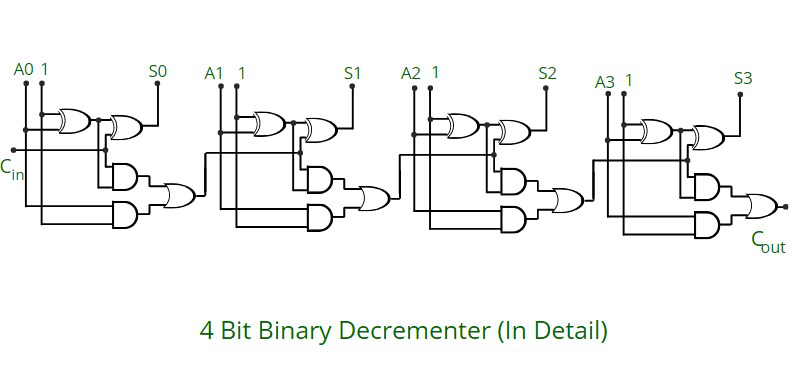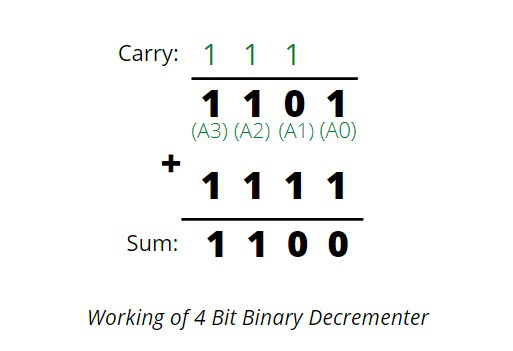什么是 4 位二进制减量器?
它从寄存器中存储的现有二进制值中减去 1 个二进制值,或者换句话说,我们可以简单地说,它将寄存器中存储的现有值减 1。
对于任何 n 位二进制递减器,“n”是指需要递减 1 的寄存器的存储容量。因此我们需要“n”个全加器。因此,在 4 位二进制递减器的情况下,我们需要 4 个全加器。

在职的:
- 它由 4 个全加器组成,一个接一个地连接。每个全加器有 3 个输入(进位输入,1,A)和 2 个输出(进位输出和 S)
- 全加器基本由 2 个半加器和一个或门组成。
- 来自前一个全加器的进位 (C) 被传播到下一个全加器。因此,一个全加器的进位输出成为下一个全加器的三个输入之一。
- 它遵循 2 的补码的概念,因此我们将 1 作为所有 4 个全加器的输入,如上图所示。
- 所以我们加 1111 以减 1。

添加1111的原因:
- 这是因为我们的主要动机是减去 1,在 4 位表示中是 0001
- 用 1 的补码表示它会得到:1110
- 用 2 的补码表示它(将 1 加到 1 的补码)将得到:1111
- 这就是为什么给出输入 1111 以在 4 位二进制递减器中获得递减输出的原因。
In 4 bit representation In 1's complement In 2's complement
1 -------------------------> 0001 ----------------------> 1110 ---------------------> 1111

例子:
(Refer to the circuit diagram from right to left for better understanding)
1. Input: 1010 ----> After using 4 bit binary decrementer ----> Output: 1001
1 0 1 0 (Comparing from the circuit 1 0 1 0 is A3, A2, A1, A0 respectively)
+ 1 1 1 1 (1 1 1 1 is added as seen in the diagram also, in each full adder 1 is taken as input)
________
1 0 1 1 ( 1 0 1 1 , in the diagram are S3, S2, S1, S0 respectively)
________
2. Input: 0010 ----> After using 4 bit binary decrementer ----> Output: 0001
1 0 1 0
+ 1 1 1 1
________
0 0 0 1
________
3. Input: 0011 ----> After using 4 bit binary decrementer ----> Output: 0001
0 0 1 1
+ 1 1 1 1
_________
0 0 1 0
_________